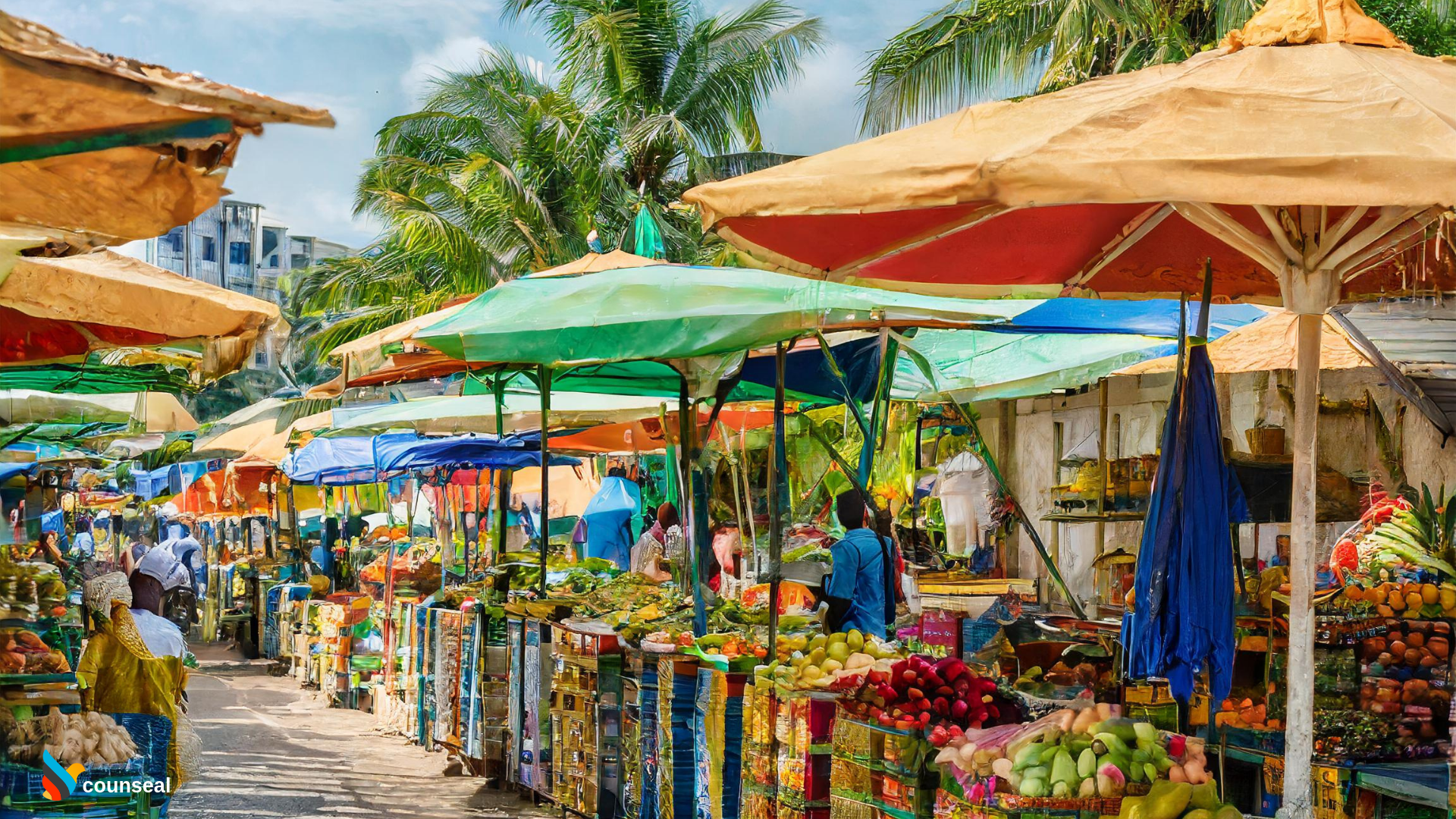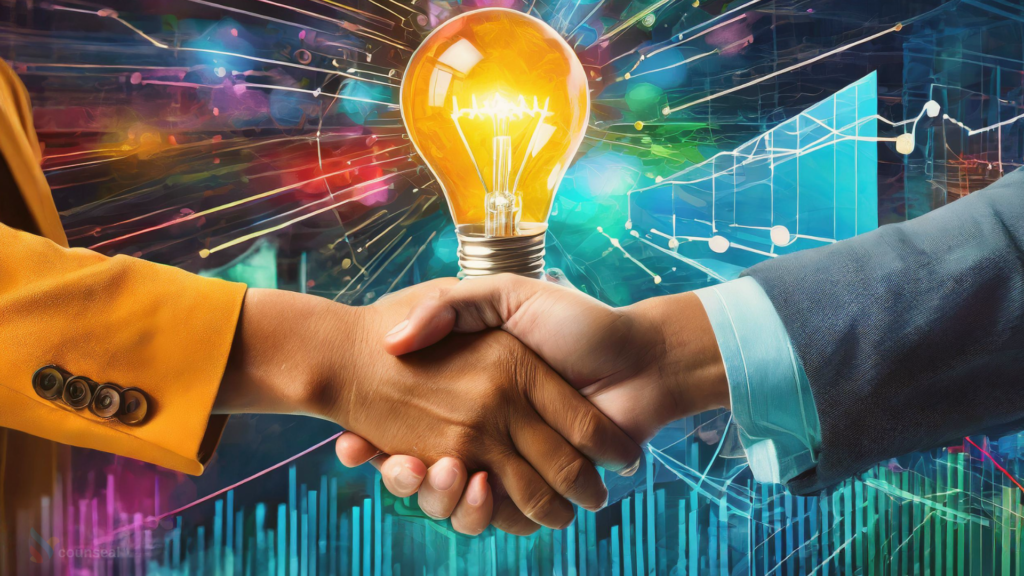Building a Strong Brand Identity for Your Nigerian Startup

by Counseal Team
Updated September 18, 2024

Imagine yourself in the heart of Lagos’ bustling market. Amidst the cacophony of sights and sounds, one vendor’s stall catches your eye. What sets it apart? A distinctive logo, meticulously arranged products, and an unmistakable presence. This, in essence, is brand identity at work. For startups in Nigeria’s dynamic landscape, a robust brand identity isn’t just a nice-to-have—it’s a necessity.
In this guide, we’ll navigate the key elements of crafting a memorable brand identity that resonates with your target audience and propels your startup to new heights. Let’s dive in.
- Why Brand Identity Matters
- The Nigerian Market: A Land of Opportunity and Challenge
- Understanding Brand Identity: More Than Just a Logo
- Steps to Building a Strong Brand Identity
- Implementing Your Brand Identity Across All Touchpoints
- Engaging with Your Audience: Building a Community Around Your Brand
- Monitoring and Adapting Your Brand Strategy
- Recap: Building Your Brand Identity in Nigeria’s Dynamic Market
Why Brand Identity Matters
A solid brand identity does more than just make your business look good—it’s the backbone of your startup’s success. Think of it as your company’s unique fingerprint: instantly recognisable and impossible to replicate. Here’s why it’s crucial:
- Differentiation: In Nigeria’s competitive market, standing out is paramount. Your brand identity is the secret sauce that sets you apart from the crowd. Without it, you risk being just another face in the sea of startups.
- Trust and Credibility: A well-crafted brand identity builds trust faster than you can say “naira”. When customers encounter a professional and consistent brand, they’re more likely to believe in your product or service. In fact, consistent brand presentation across all platforms can increase revenue by up to 23%, according to a study by Lucidpress.
- Customer Loyalty: Consumers don’t just buy products; they buy into brands. A compelling brand identity fosters an emotional connection that keeps customers coming back. It’s why you might choose Star beer over a generic lager, even if they taste similar.

The Nigerian Market: A Land of Opportunity and Challenge
Nigeria, Africa’s powerhouse, boasts a vibrant and diverse market. With over 200 million potential customers, it’s a goldmine for startups. However, like any treasure hunt, it comes with its fair share of obstacles.
The Nigerian Consumer: Brand-Savvy and Value-Driven
Nigerian consumers are a unique breed:
- Brand-Conscious: Nigerians love their brands. They associate branded products with quality and prestige. A Nielsen report revealed that 60% of Nigerian consumers prefer buying branded products.
- Social Media Aficionados: With over 33 million active social media users, platforms like Instagram, Facebook, and Twitter are crucial for brand engagement. In Nigeria, social media isn’t just for selfies—it’s a powerful tool for brand building.
- Value Seekers: While quality is important, Nigerians are always on the lookout for value for money. They want the best bang for their naira.
Navigating the Choppy Waters
Building a brand in Nigeria is like sailing through unpredictable waters. The potential rewards are immense, but so are the challenges:
- Economic Volatility: Frequent policy changes, inflation, and currency fluctuations can impact purchasing power and business operations faster than you can say “devaluation”.
- Infrastructure Hurdles: Unreliable power supply and poor road networks can affect logistics and overall business efficiency. It’s not uncommon for businesses to become their own mini power companies.
- Regulatory Maze: Navigating the regulatory landscape can be trickier than finding your way through Lagos traffic. Complying with various laws and regulations requires time, resources, and often, a lot of patience.
The Silver Lining
Despite the challenges, the Nigerian market is brimming with opportunities:
- Growing Middle Class: The rising middle class means more disposable income and a greater appetite for quality products and services.
- Youthful Population: With a median age of 18, Nigeria has a dynamic population eager to embrace new brands and innovations.
- Tech Revolution: Nigeria is fast becoming Africa’s tech hub. The rapid adoption of technology provides fertile ground for innovative startups.
Case Study: Paystack’s Brand Identity Success
Take Paystack, for instance. This Nigerian fintech startup has become the poster child for brand identity done right. With a clear and compelling brand message, professional branding, and consistent customer engagement, Paystack gained trust and loyalty in a notoriously difficult sector. Their success culminated in a $200 million acquisition by Stripe in 2020, proving that a strong brand identity can drive monumental success even in challenging markets.
Understanding Brand Identity: More Than Just a Logo
Now that we’ve set the stage, let’s delve deeper into what brand identity really means. It’s more than just a snazzy logo or a catchy colour palette—it’s the DNA of your business.
The Anatomy of Brand Identity
Think of brand identity as the personality of your business. It encompasses:
- Visual Elements: This includes your logo, colour scheme, typography, and overall design aesthetic. It’s the face your brand shows to the world.
- Values and Mission: The core principles that drive your business and what you aim to achieve. It’s the heart of your brand.
- Customer Experience: How you interact with your customers across all touchpoints. It’s the soul of your brand.
Brand Identity vs Brand Image: Two Sides of the Same Coin
It’s easy to confuse brand identity with brand image, but they’re distinct concepts:
- Brand Identity: How you define and present your brand. It’s within your control.
- Brand Image: How your audience perceives your brand. It’s influenced by your identity but shaped by customer experiences and perceptions.
Think of it this way: if your brand were a person at a party, your brand identity would be the carefully chosen outfit and practiced introduction. Your brand image would be what people think of you after chatting for a while.
Why Brand Identity is Crucial for Nigerian Startups
Standing Out in a Sea of Sameness
In a market with over 41.5 million SMEs (according to the National Bureau of Statistics), differentiation is key. A strong brand identity helps you carve out your niche and become memorable.
Consider Paystack again. When they entered the fintech scene, there were already several payment solutions. But their clear, consistent brand identity—centered around simplicity and efficiency—set them apart. Today, they’re one of the most recognised fintech brands in Nigeria.
Building Trust in a Skeptical Market
Trust is the currency of business, especially in Nigeria where skepticism towards new brands is high. A consistent brand identity builds trust and credibility. When customers know what to expect from your brand, they’re more likely to give you a chance.
Take GTBank, for example. Their consistent orange and black branding, coupled with their straightforward communication, has made them one of the most trusted banks in Nigeria. They didn’t just build a bank; they built a brand that Nigerians trust.
Creating Brand Advocates
A strong brand identity not only attracts customers but turns them into loyal advocates. When people resonate with your brand, they become your unofficial marketing team.
Look at Jumia. Their branding is consistent across all touchpoints—website, app, social media, and even packaging. This consistency creates a seamless experience, making it easier for customers to trust the brand and remain loyal. Happy customers become brand ambassadors, spreading the word faster than any ad campaign could.

Building a strong brand identity is not a one-off task—it’s an ongoing process of maintaining consistency and evolving with your audience. And trust us, in Nigeria’s dynamic market, it’s worth every ounce of effort.
Steps to Building a Strong Brand Identity
Now that we’ve covered the ‘why’, let’s roll up our sleeves and dive into the ‘how’. Building a strong brand identity is like constructing a skyscraper in Lagos—it requires a solid foundation, careful planning, and attention to detail.
Define Your Brand’s Purpose and Values
First things first—you need to know who you are before you can tell others. Your brand’s purpose and values are the bedrock of your identity.
Identifying Your Mission and Vision
Think of your mission as your current goal and your vision as your future aspiration. For instance, Paystack’s mission was to make online payments in Nigeria seamless, while their vision extended to powering growth for businesses across Africa.
To define yours, ask yourself:
- What problem are we solving?
- Who are we serving?
- Where do we see ourselves in 5, 10, 20 years?
Conduct Market and Competitor Research
Before you charge into the market, you need to know the lay of the land. Think of it as reconnaissance before a battle.
Analyzing the Market Landscape
Start by answering these questions:
- Who are your competitors?
- What are their strengths and weaknesses?
- Where are the gaps in the market?
Tools like SEMrush and Ahrefs can help you analyse competitors’ online presence. Don’t just look at what they’re doing well—look for what they’re missing. That’s your opportunity.
Develop Your Brand Positioning and Messaging
Now that you know who you are and what you’re up against, it’s time to stake your claim in the market.
Crafting a Unique Value Proposition (UVP)
Your UVP should succinctly answer why someone should choose your brand over others. It’s not about being the best in the world, but the best for your audience.
Take Flutterwave, for example. Their UVP is clear: “A payment solution for global merchants and payment service providers.” This clarity resonates with their target audience and drives their messaging across all channels.
To craft your UVP, consider:
- What unique benefit do you offer?
- How do you solve your customers’ problems differently?
- Why should anyone care about your brand?
Design Your Visual Brand Identity
Now for the fun part—giving your brand a face. Your visual identity is often the first thing people notice about your brand.
Key elements include:
- Logo: Keep it simple, memorable, and versatile. It should look good on a billboard and a business card.
- Colour Scheme: Choose colours that reflect your brand personality and resonate with your audience. Remember, colours evoke emotions.
- Typography: Select fonts that complement your overall aesthetic and are easily readable.
Tools like Canva and Adobe Spark can be invaluable in this process, especially if you’re on a startup budget.
Create Brand Guidelines and Standards
Consistency is key in branding. Brand guidelines ensure that your brand elements are used correctly across all platforms, maintaining a cohesive identity.
Example: Brand Guidelines from Successful Nigerian Companies
Take a leaf out of GTBank’s book. Their brand guidelines are meticulously detailed, covering logo placement, colour codes, and even social media post formats. This consistency has made them one of the most recognisable brands in Nigeria.
Your brand guidelines should cover:
- Logo usage (size, placement, variations)
- Colour palette (primary and secondary colours with hex codes)
- Typography (primary and secondary fonts)
- Tone of voice (how your brand communicates)
- Imagery style (types of images to use in marketing materials)
Remember, building a strong brand identity is an ongoing process. Keep refining and evolving your brand as your business grows. The key is to stay true to your core values while adapting to the ever-changing Nigerian market.

Implementing Your Brand Identity Across All Touchpoints
You’ve laid the groundwork for your brand identity. Now it’s time to bring it to life across every interaction your customers have with your business. In the digital age, consistency is king, and every touchpoint is an opportunity to reinforce your brand.
Website: Your Digital Storefront
Your website is often the first in-depth interaction potential customers have with your brand. It’s your 24/7 salesperson, and it needs to look the part.
- Visual Consistency: Your logo, colour palette, and typography should be consistent across all pages. Flutterwave, for instance, uses its signature shade of orange consistently across its website, making its brand instantly recognisable.
- Content Tone and Voice: Whether it’s your homepage, blog, or product descriptions, the tone of your content should reflect your brand’s personality. Are you formal or casual? Humorous or serious? Paystack maintains a friendly and approachable tone throughout its site, aligning perfectly with its brand promise of making payments seamless.
- User Experience (UX): A well-designed website is easy to navigate and offers a smooth user experience. This includes fast loading times, mobile responsiveness, and intuitive design. Konga, a Nigerian e-commerce platform, excels at this by offering a clutter-free and user-friendly interface.
Social Media: Where Your Brand Personality Shines
Social media platforms are where you can let your brand’s personality truly shine. Here’s how to keep your brand identity consistent across different platforms:
- Unified Visuals: Just like your website, your social media profiles should use the same visuals. This means your profile pictures, cover photos, and even the filters you use on your images should be consistent. Jumia Nigeria uses the same logo and colour scheme across all its social media platforms, creating a seamless brand experience.
- Consistent Posting Style: The tone you set on your website should carry over to your social media posts. If your website is friendly and casual, your social media should be too. GTBank’s social media presence is a great example of this. Their posts are informative yet conversational, making them relatable to their audience.
- Engagement: Social media is not a monologue; it’s a dialogue. Engage with your followers by responding to comments, asking questions, and encouraging user-generated content. Zaron Cosmetics, a Nigerian beauty brand, excels at this by regularly featuring user-generated content and engaging with its audience through comments and direct messages.
Packaging: The Tactile Brand Experience
In the e-commerce era, packaging is often overlooked, but it’s a crucial touchpoint for your brand. It’s the first physical interaction a customer has with your product.
- Design Consistency: Your packaging should reflect your brand’s visual identity. This includes your logo, colours, and fonts. Farmcrowdy, an agritech startup, uses eco-friendly packaging that aligns with its brand’s commitment to sustainability.
- Quality: The quality of your packaging speaks volumes about your brand. Cheap or flimsy packaging can diminish your brand’s perceived value. Nigerian beverage brand, Zobo King, uses high-quality, recyclable materials for its packaging, reinforcing its premium market positioning.
- Unboxing Experience: The unboxing experience can leave a lasting impression on your customers. Include small touches like thank-you notes, branded stickers, or even a small freebie. This not only enhances the customer experience but also encourages social sharing. Luxury fashion brand, Deola Sagoe, excels in creating a memorable unboxing experience with its elegant and meticulously designed packaging.

Remember, every interaction with your brand is an opportunity to reinforce your identity and leave a lasting impression. By maintaining consistency across all touchpoints, you create a cohesive brand experience that builds trust and loyalty among your Nigerian audience.
Engaging with Your Audience: Building a Community Around Your Brand
Creating a strong brand isn’t just about visuals and messaging; it’s about fostering a community that resonates with your brand values. In Nigeria’s vibrant market, community building can be your secret weapon for brand loyalty and growth.
Building a Community: More Than Just Customers
Transform your customers into brand advocates by creating a community around your brand. Here’s how:
- Content Marketing: Share valuable content that resonates with your audience. This could be blog posts, videos, or infographics. Techpoint Africa, a Nigerian tech blog, engages its audience with in-depth articles and industry reports, establishing itself as a thought leader in the tech space.
- Events and Webinars: Host events or webinars to bring your community together and offer value beyond your products or services. Andela, a Nigerian startup that trains software developers, hosts regular webinars and coding bootcamps, creating a strong community of tech enthusiasts.
- Loyalty Programs: Reward your loyal customers with exclusive per ks, giveaways, discounts, or early access to new products. This not only retains customers but also encourages word-of-mouth marketing. For instance, Konga’s loyalty programme offers points for purchases, reviews, and referrals, incentivising customer engagement and repeat business.
Effective Audience Engagement Strategies
Engagement goes beyond likes and shares. It’s about creating meaningful interactions that reinforce your brand identity. Here are some strategies that Nigerian startups are using effectively:
- Personalisation: Tailor your interactions based on customer data. Send personalised emails, offer product recommendations, or provide customised discounts. Jiji.ng, a Nigerian e-commerce platform, excels at this by sending personalised product recommendations based on browsing history, enhancing the user experience and increasing the likelihood of purchases.
- Interactive Content: Use polls, quizzes, and interactive stories to engage your audience. Pulse Nigeria, a popular news platform, uses Instagram Stories to run polls and quizzes, keeping its audience engaged and entertained while reinforcing its brand as a dynamic, youth-oriented news source.
- User-Generated Content: Encourage your customers to create content featuring your products. This not only provides you with free content but also builds trust among potential customers. Nigerian fashion brand Aso-oke by Eeswat regularly features customer photos on its social media profiles, showcasing its products in real-life settings and fostering a sense of community.

By implementing these strategies, you’re not just building a brand; you’re creating a community that believes in and supports your vision. This community can become your most powerful marketing tool, driving growth and loyalty in the competitive Nigerian market.
Monitoring and Adapting Your Brand Strategy
In the fast-paced Nigerian market, a set-it-and-forget-it approach to branding is a recipe for obsolescence. Successful brands are those that continuously monitor their performance and adapt to changing market dynamics. Let’s explore how to keep your finger on the pulse of your brand’s health and stay ahead of the curve.
Measuring Brand Performance: The Metrics That Matter
Think of measuring brand performance as tuning a car engine – you need to check the right metrics to ensure everything runs smoothly.
Key Metrics to Track
- Brand Awareness: Are people recognising your brand? Tools like Google Trends and social media analytics can help gauge how much buzz your brand is generating. For instance, track mentions of your brand name across social media platforms and online forums.
- Brand Loyalty: Repeat customers are the lifeblood of any business. Keep an eye on customer retention rates and Net Promoter Scores (NPS). These metrics will tell you not just how many people are coming back, but how likely they are to recommend your brand to others.
- Brand Equity: This is all about the value your brand adds to your products or services. Use surveys to measure perceptions of your brand compared to competitors. For example, would customers be willing to pay a premium for your product over a generic alternative?
- Conversion Rates: This is where the rubber meets the road. Use tools like Google Analytics to see how many visitors are taking desired actions on your website, whether it’s making a purchase or signing up for a newsletter.
Tools and Techniques for Monitoring
- Google Analytics: A must-have for detailed insights into website traffic and user behaviour. Pair this with Google Search Console to monitor your search performance and identify any issues affecting your visibility.
- Social Media Management Tools: Platforms like Hootsuite and Buffer allow you to schedule posts and track engagement. These tools offer analytics to see which content resonates most with your audience.
- Customer Feedback Tools: SurveyMonkey and Typeform are excellent for creating and distributing surveys. These tools help you gather insights directly from your customers, providing valuable data to tweak your brand strategy.
Adapting to Market Changes: Staying Relevant in a Dynamic Market
The Nigerian market is a living, breathing entity, constantly evolving. Staying relevant means being agile and ready to pivot when necessary.
Strategies for Staying Ahead
- Keep an Ear to the Ground: Subscribe to industry news, join relevant forums, and follow key influencers in your niche. Being aware of trends and shifts can give you a heads-up on when it’s time to adapt.
- Engage Regularly with Your Audience: Social media is your friend here. Run polls, ask for feedback, and actually listen to what your customers are saying. This will not only keep you informed but also build a community around your brand.
- Embrace Innovation: Don’t be afraid to experiment with new technologies or marketing strategies. For instance, as mobile usage continues to soar in Nigeria, ensure your brand is optimised for mobile platforms.
Examples of Nigerian Brands That Successfully Adapted
- GTBank: Shifted focus to digital banking solutions in response to the growing trend of online transactions. Their USSD banking service and robust mobile app have kept them at the forefront of Nigeria’s banking sector.
- Jumia: Pivoted its business model to offer a wider range of products and services, adapting to the diverse needs of Nigerian consumers. They’ve also introduced Jumia Pay to tap into the growing fintech market.
- Interswitch: A pioneer in the digital payment space, Interswitch has continuously evolved its offerings to stay ahead of the curve. By investing in innovative solutions like the Quickteller platform, they’ve maintained their position as a market leader.
- Dufil Prima Foods: The makers of Indomie noodles have not only diversified their product range but also adapted their marketing strategies to appeal to different demographics, ensuring they remain a household name in Nigeria.

In conclusion, monitoring and adapting your brand strategy is akin to steering a ship through unpredictable waters. By keeping an eye on key metrics and being prepared to pivot, you can navigate your brand to success in the dynamic Nigerian market. Stay sharp, stay engaged, and most importantly, stay adaptable.
Recap: Building Your Brand Identity in Nigeria’s Dynamic Market
We’ve traversed the intricate landscape of brand identity in Nigeria’s vibrant market. Let’s recap the key points to help you forge a brand that not only survives but thrives in this dynamic environment:
- Understand the Importance: A strong brand identity differentiates you in a crowded market, builds trust, and fosters customer loyalty.
- Know Your Market: The Nigerian consumer is brand-conscious, social media savvy, and value-driven. Tailor your brand to meet these unique characteristics.
- Define Your Brand: Articulate your purpose, values, mission, and vision. These form the core of your brand identity.
- Research and Position: Conduct thorough market research and craft a unique value proposition that sets you apart.
- Design Your Visual Identity: Create a cohesive visual brand with a memorable logo, consistent colour scheme, and appropriate typography.
- Implement Across Touchpoints: Ensure your brand identity is consistently applied across your website, social media, packaging, and all customer interactions.
- Engage Your Audience: Build a community around your brand through content marketing, events, and loyalty programmes.
- Monitor and Adapt: Regularly track your brand performance and be ready to evolve with the changing market dynamics.
Remember, building a strong brand identity is not a one-time effort but an ongoing journey. It requires consistency, creativity, and a deep understanding of your audience.

Taking the Next Step
Building a robust brand identity for your Nigerian startup is a complex but rewarding endeavour. It’s the foundation upon which you’ll build customer trust, market presence, and ultimately, business success.
If you’re ready to elevate your brand identity and navigate the intricacies of the Nigerian market, don’t go it alone. At counseal.com, we specialise in guiding ambitious Nigerian entrepreneurs like you through the brand-building process.
Whether you need assistance with market research, crafting your brand story, or designing your visual identity, our team of experts is here to help. We understand the unique challenges and opportunities of the Nigerian market, and we’re committed to helping your brand stand out and thrive.
Take the first step towards building an unforgettable brand. Remember, in the words of Amazon founder Jeff Bezos, “Your brand is what other people say about you when you’re not in the room.” Let’s make sure they’re saying something remarkable.





